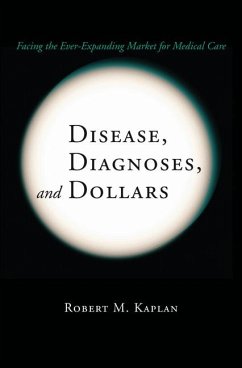Disease, Diagnoses, and Dollars
Facing the Ever-Expanding Market for Medical Care
Robert M. Kaplan, UCLA School of Public Health, Los Angeles, CA
Close to 50 Million Uninsured,
Steeply Rising Insurance Premiums,
Employers Cutting Healthcare Benefits . . .
There's plenty wrong with this picture. In Disease, Diagnoses, and Dollars, public health expert Robert Kaplan takes America's healthcare industry to task and challenges readers to examine their own roles in it.
Provocative, timely, and comprehensively researched, this book analyzes the current healthcare crisis in terms of medical culture, economics, and advertising. The findings reveal a system fraught with conflicts-contradictory healthcare policies, providers who over-test and over-prescribe, patients with unrealistic demands fueled by the media-and throughout, an absence of accountability. Much of preventive medicine, Kaplan persuasively argues, comes down to the selling of expensive pills and procedures that drive up costs while subjecting the population to unneeded risks and complications. And the end result, he argues, is excess care for many people, and a dearth of care for many more.
Kaplan's informed, practical, and constructive approach makes Disease, Diagnoses, and Dollars a "must-read" volume for policymakers and professionals in public health and healthcare, and for business owners as well as ordinary citizens and consumers concerned with the viability of healthcare in America.
Facing the Ever-Expanding Market for Medical Care
Robert M. Kaplan, UCLA School of Public Health, Los Angeles, CA
Close to 50 Million Uninsured,
Steeply Rising Insurance Premiums,
Employers Cutting Healthcare Benefits . . .
There's plenty wrong with this picture. In Disease, Diagnoses, and Dollars, public health expert Robert Kaplan takes America's healthcare industry to task and challenges readers to examine their own roles in it.
Provocative, timely, and comprehensively researched, this book analyzes the current healthcare crisis in terms of medical culture, economics, and advertising. The findings reveal a system fraught with conflicts-contradictory healthcare policies, providers who over-test and over-prescribe, patients with unrealistic demands fueled by the media-and throughout, an absence of accountability. Much of preventive medicine, Kaplan persuasively argues, comes down to the selling of expensive pills and procedures that drive up costs while subjecting the population to unneeded risks and complications. And the end result, he argues, is excess care for many people, and a dearth of care for many more.
Kaplan's informed, practical, and constructive approach makes Disease, Diagnoses, and Dollars a "must-read" volume for policymakers and professionals in public health and healthcare, and for business owners as well as ordinary citizens and consumers concerned with the viability of healthcare in America.
Dieser Download kann aus rechtlichen Gründen nur mit Rechnungsadresse in A, B, BG, CY, CZ, D, DK, EW, E, FIN, F, GR, HR, H, IRL, I, LT, L, LR, M, NL, PL, P, R, S, SLO, SK ausgeliefert werden.
From the reviews:
"This book discusses points of tension in the U.S. healthcare system and places the burden on readers to critically think about the paradoxes consumers face. ... The intended audience includes health providers and consumers." (Carole A. Kenner, Doody's Review Service, February, 2009)
"Disease, Diagnoses, and Dollars is an exceptionally practical, carefully argued study of what can be done to control health care costs by improving the approach to medical decision making. Kaplan persuasively demonstrates the practical wisdom he has learned from wide-ranging research and insightful clinical observations. His book challenges the assumptions of patients and physicians. I believe that many of his concrete recommendations can save not only dollars but the health of patients and the satisfaction of physicians in their professional practice." (James F. Bresnahan, JAMA, Vol 302, No. 3)
"This book discusses points of tension in the U.S. healthcare system and places the burden on readers to critically think about the paradoxes consumers face. ... The intended audience includes health providers and consumers." (Carole A. Kenner, Doody's Review Service, February, 2009)
"Disease, Diagnoses, and Dollars is an exceptionally practical, carefully argued study of what can be done to control health care costs by improving the approach to medical decision making. Kaplan persuasively demonstrates the practical wisdom he has learned from wide-ranging research and insightful clinical observations. His book challenges the assumptions of patients and physicians. I believe that many of his concrete recommendations can save not only dollars but the health of patients and the satisfaction of physicians in their professional practice." (James F. Bresnahan, JAMA, Vol 302, No. 3)









